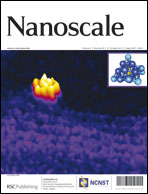We measure the frequency of collective molecular precession as a function of temperature in the ferroelectric liquid crystalline monolayer at the water–air interface. This movement is driven by the unidirectional flux of evaporating water molecules. The collective rotation in the monolayer with angular velocities ω ∼ 1 s−1 (at T = 312 K) to 10−2 s−1 (at T = 285.8 K) is 9 to 14 orders of magnitude slower than rotation of a single molecule (typically ω ∼ 109 to 1012 s−1). The angular velocity reaches 0 upon approach to the two dimensional liquid-to-solid transition in the monolayer at T = 285.8 K. We estimate the rotational viscosity, γ1, in the monolayer and the torque, Γ, driving this rotation. The torque per molecule equals Γ = 5.7 × 10−8 pN nm at 310 K (γ1 = 0.081 Pa s, ω = 0.87 s−1). The energy generated during one turn of the molecule at the same temperature is W = 3.5 × 10−28 J. Surprisingly, although this energy is 7 orders of magnitude smaller than the thermal energy, kBT (310 K) = 4.3 × 10−21 J, the rotation is very stable. The potential of the studied effect lies in the collective motion of many (>1012) “nano-windmills” acting “in concerto” at the scale of millimetres. Therefore, such systems are candidates for construction of artificial molecular engines, despite the small energy density per molecular volume (5 orders of magnitude smaller than for a single ATPase).

This article is Open Access
 Please wait while we load your content...
Something went wrong. Try again?
Please wait while we load your content...
Something went wrong. Try again?


 Please wait while we load your content...
Please wait while we load your content...